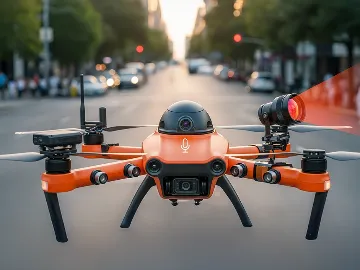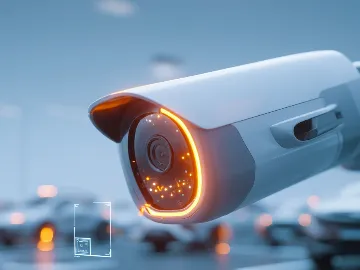Two major technologies are shaping automated visual inspection and data analysis: machine vision and computer vision. Both promise to enhance operational efficiency and ensure quality across various industries, but knowing which to implement-and when-can be a significant hurdle. Whether machine vision suits your needs or you should use computer vision development services for deeper data insights can make a big difference in the business future.
We'll explore the applications and key differences between machine vision vs computer vision.
What is machine vision?
Machine vision is a branch of engineering and computer science focused on replicating human visual perception using cameras, sensors, and algorithms to automate visual inspection and analysis tasks. The primary function of machine vision is to capture visual data from the environment using high-quality cameras and then process this data to perform various tasks, such as detecting objects or inspecting products for defects.
Machine vision is highly effective in applications that require rapid, automated decision-making with low-to-medium complexity. They are integral to industrial processes like robotic welding, conveyor sorting, and automated assembly lines, enhancing the precision and efficiency of operations without human intervention.
Machine vision systems consist of several key elements that work together to capture, process, and analyze visual data:
- Cameras form the core of any machine vision system, capturing high-resolution images or videos of the inspected objects. They can range from simple 2D to advanced 3D.
- Sensors detect the presence of objects, measure distances, and provide feedback on environmental conditions such as temperature and lighting.
- Proper lighting helps to obtain clear, consistent, and free of shadows or reflection images. Here, different types of lighting, such as LED, fluorescent, and infrared, optimize image quality based on requirements.
- Machine vision software is responsible for processing the captured images and analyzing the visual data. This software uses algorithms to identify patterns, measure dimensions, detect defects, and make decisions based on pre-defined criteria.

How is computer vision different?
Computer vision focuses on enabling computer systems to achieve human-like visual perception. It involves processing, analyzing, and interpreting visual data from the world, allowing computers to recognize meaningful information from images and videos. The goal of computer vision systems is to give machines the ability to understand and analyze complex visual environments as effectively or even more effectively than humans.
Computer vision utilizes more advanced and flexible technologies and algorithms. That makes this vision system more capable of handling various tasks in dynamic environments. Central to computer vision are deep learning models, especially convolutional neural networks (CNNs), which automatically learn to extract relevant features from visual data. These models are tested on datasets to identify patterns, objects, and scenes, allowing them to generalize and perform well in diverse conditions. Computer vision also incorporates advanced methodologies such as reinforcement learning and generative adversarial networks.
Unlike machine vision, primarily used in controlled environments and focusing on specific, straightforward tasks, computer vision is versatile and can be applied independently of other systems. It goes beyond simple image processing by extracting rich, detailed information from visual data. Computer vision handles tasks such as object detection, facial recognition, and image segmentation with precision and speed.

Related: Computer vision system: challenges, benefits, use cases
Master real-time precision with edge computer vision – get the practical guide!


Success!

Machine vision vs computer vision: main differences
Data processing
Machine vision relies heavily on rule-based data processing techniques. These systems use predefined rules and simple algorithms to analyze visual data and make decisions. The system triggers an action if an image matches a particular pattern or threshold.
- Pros: Rule-based processing is highly predictable and easy to implement. It provides consistency in environments where the conditions are stable, and the tasks are repetitive for quality control and inspection in manufacturing.
- Cons: The inflexibility of rule-based systems means they need help with variations and exceptions. Unanticipated changes in the visual data during setup may cause errors or necessitate costly reprogramming.
Computer vision employs algorithmic learning, primarily Machine Learning and deep learning models. These systems learn from large datasets and improve their performance over time. Rather than relying on fixed rules, computer vision systems adapt based on the data they process. This feature makes them capable of handling complex and dynamic environments.
- Pros: Algorithmic learning allows for greater flexibility and adaptability. Computer vision systems can learn from experience, improve accuracy, and handle various scenarios without needing explicit programming for each new task.
- Cons: The complexity of algorithmic learning requires extensive data and computational resources. Training can be time-consuming and resource-intensive, and the systems may need regular updates to maintain optimal performance.
Hardware and software requirements
Machine vision systems typically require specialized hardware tailored to specific applications. They consist of industrial cameras, lighting systems, image sensors, and frame grabbers designed to operate in controlled environments. The software is generally straightforward, focusing on rule-based algorithms to perform specific tasks.
- Pros: The specialized hardware and focused software design guarantee reliability and consistency in performance. Given their tailored design, machine vision systems are often easier to integrate into existing manufacturing setups.
- Cons: The reliance on specialized hardware can limit flexibility and scalability. Machine vision systems may require significant modifications to adapt to new tasks or environments.
Computer vision systems leverage more general-purpose hardware, such as GPUs (Graphics Processing Units), for intensive computation. The software stack includes advanced AI and machine learning frameworks, like TensorFlow, PyTorch, and OpenCV, which enable complex data processing and analysis.
- Pros: Using general-purpose hardware and versatile software allows computer vision systems to adapt to a wide range of applications. It's easy to scale them by upgrading computational resources or incorporating new algorithms.
- Cons: The need for powerful hardware and complex software can make computer vision systems more expensive to implement and maintain. The reliance on advanced technologies also requires skilled personnel for development and upkeep.
Speed and latency
Machine vision systems optimize real-time processing with minimal latency. They handle high-speed tasks requiring quick decision-making, such as sorting, inspection, and robotic guidance on production lines.
- Pros: Machine vision systems can process images almost instantaneously, making them ideal for environments that require rapid throughput. The low latency results in immediate actions, reducing delays and increasing productivity.
- Cons: While fast, machine vision's speed comes at the expense of flexibility. The focus on speed may limit the system's ability to handle more complex or varied tasks, as the algorithms are often simplified to meet real-time processing needs.
While capable of real-time processing, computer vision often requires more computational resources, which can introduce latency, especially in applications involving large datasets or complex models. The need to process multiple data layers means that computer vision may be slower than machine vision in specific scenarios.
- Pros: Computer vision can handle more complex tasks that require detailed analysis and decision-making, even if it means sacrificing some speed. It's particularly effective in applications where depth and accuracy are more critical than immediate results.
- Cons: The processing speed of computer vision systems can be a drawback in time-sensitive environments. High computational demands may lead to delays, especially when dealing with large-scale data or requiring extensive analysis.
Image processing vs analysis
Machine vision systems focus on image processing, which involves converting visual data into a format for specific, predefined tasks. Such processing typically includes filtering, thresholding, and edge detection to identify features of interest, such as defects or alignment in an assembly line.
- Pros: Machine vision's image processing capabilities optimize speed and simplicity. It can perform real-time processing with minimal computational overhead, useful for high-speed manufacturing environments.
- Cons: This approach is limited to specific, rule-based tasks and needs more flexibility to interpret complex or unexpected visual data. Machine vision systems may need help to adapt to new scenarios that require a deeper understanding of the image content.
Computer vision, in contrast, focuses on image analysis, which goes beyond mere processing to include understanding and interpreting visual data. The process involves using machine learning models to identify patterns, classify objects, and make predictions based on the visual input.
- Pros: Image analysis allows computer vision systems to handle various applications, from facial recognition and autonomous driving to medical diagnostics and retail analytics. CV systems can learn and adapt over time, improving their performance and accuracy with exposure to more data.
- Cons: Image analysis is computationally intensive and requires substantial processing power and large datasets for training. As a result, it can lead to increased costs and longer development times, particularly for applications that require real-time analysis.
Integration vs standalone use
Machine vision typically integrates into larger automation setups, such as production lines or robotic systems. They rely on specific hardware and software for seamless integration with existing industrial processes.
- Pros: Integration into existing systems allows machine vision to operate with other machinery, enhancing overall efficiency and productivity. This approach is particularly beneficial in manufacturing environments where automation is fundamental to scaling operations.
- Cons: The need for integration can limit flexibility and increase setup time and costs. Machine vision systems may require significant customization to fit specific applications, and changes in the production process can necessitate costly reconfiguration.
Depending on the application, computer vision systems can function as standalone solutions or integrate into more extensive systems. They are versatile and can work independently, analyzing data from various sources without being tied to a specific hardware setup.
- Pros: The flexibility to operate as standalone systems or integrate with existing infrastructure is helpful for various applications, from security and surveillance to autonomous vehicles and retail analytics. This versatility can reduce implementation time and costs, as the systems can be adapted to different needs without extensive hardware changes.
- Cons: While flexible, standalone computer vision systems may require additional effort to integrate with existing workflows or systems. The need for advanced hardware and software can also increase the initial investment and ongoing maintenance costs.
Real-time vs historical image processing
Comparing machine vision vs computer vision, the first systems are designed for real-time image processing, enabling immediate decision-making and action based on the visual input. This capability is crucial in applications like vision quality inspection, where rapid detection of defects or errors is essential to maintain production efficiency and minimize waste.
- Pros: Real-time processing ensures quick decisions and keeping up with fast-paced environments like assembly lines and automated sorting systems. This immediacy reduces downtime and increases overall throughput, leading to higher operational efficiency.
- Cons: The focus on real-time processing may limit the system's ability to handle more complex tasks that require in-depth analysis. Machine vision systems may struggle with applications requiring extensive data processing or decision-making beyond simple rule-based actions.
Computer vision systems can handle both real-time and historical image processing. They can analyze live video feeds for immediate insights or process stored images and videos to extract valuable information over time.
- Pros: The ability to process both real-time and historical data allows computer vision systems to provide deeper insights and more comprehensive analysis. This versatility benefits applications like traffic monitoring, where understanding patterns over time is as essential as real-time decision-making.
- Cons: The need to handle diverse processing tasks can increase computer vision systems' complexity and computational requirements. Ensuring real-time performance while managing large datasets and complex analyses may require significant hardware and software resources.

Read more: Computer Vision vs Machine Learning: In-depth comparison
Applications of machine vision vs computer vision
Machine vision systems operate in highly controlled, structured environments, such as manufacturing floors and production lines. These environments feature consistent lighting, fixed camera positions, and predictable object presentations, effective for machine vision's rule-based algorithms.
Typical machine vision use cases include:
- Inspects products for defects and facilitates correct assembly in real-time, enhancing product quality and reducing waste;
- Guides robots in performing precise tasks like picking, placing, and assembly, particularly in structured environments;
- Scans codes quickly and accurately for inventory management and logistics optimization;
- Verifies packaging integrity by checking for correct labels, seals, and product placement;
- Detects surface defects, scratches, or dents on various materials, ensuring high-quality standards in production.
On the other hand, computer vision functions in dynamic, unstructured environments where conditions can change rapidly and unpredictably. It can process various visual inputs, including images, videos, and sensor data from different sources, such as thermal cameras and LiDAR.
Computer vision applications include:
- Enables real-time object detection, lane recognition, and obstacle avoidance for safe navigation;
- Analyzes medical images like X-rays and MRIs to assist in detecting diseases and abnormalities;
- Tracks customer behavior and engagement through video feeds, helping to optimize store layouts and marketing strategies;
- Identifies individuals in security systems and provides personalized user experiences in consumer electronics;
- Analyzes satellite or drone imagery to monitor environmental changes, detect deforestation, and assess natural disaster impacts.
Explore more details on computer vision use cases

Over 23 years, our experts have helped clients in telecom, fintech, automotive, agritech, manufacturing, and other industries build and scale effective solutions and optimize costs.
In the area of computer vision, N-iX has delivered several high-impact projects from computer vision consulting services to development. One of our notable collaborations is with Redflex, an Australian-based company that develops intelligent transport solutions. We created a solution with computer vision and deep learning to identify an offender behind the wheel and prevent accidents on the road.
In another case, we worked with a global Fortune 100 manufacturing company to enhance its inventory management across increasing warehouses. Our team automated goods tracking through an integrated computer vision system, minimizing manual work and optimizing warehouse operations.
Read more: How to find a reliable computer vision development company?
How machine vision and computer vision relate to each other
Integrating machine vision and computer vision creates a hybrid system that leverages both strengths. In manufacturing, machine vision manages immediate, on-the-line quality inspections, ensuring all products adhere to specifications during production. Meanwhile, computer vision analyzes data from these inspections to detect patterns, identify root causes of recurring issues, and suggest process improvements. This dual approach of machine vision vs computer vision boosts immediate operational efficiency and provides strategic insights that drive long-term process optimization.
The boundaries between machine vision vs computer vision are becoming increasingly blurred as AI and deep learning advancements enable more sophisticated visual recognition capabilities in both fields.
Final remarks
While often used interchangeably, machine vision vs computer vision have distinct purposes and functionalities that cater to different operational needs. Recognizing where each technology fits best-whether in a highly controlled environment requiring precise, repeatable actions or in a dynamic setting that demands adaptive, data-driven analysis-allows businesses to deploy these technologies effectively, maximizing their return on investment.
Choosing the right technology between machine vision vs computer vision and successfully integrating it into your operations can be complex. To navigate the process effectively, it is invaluable to partner with experts who demonstrate a deep understanding of computer vision vs machine vision and how these technologies can meet your business needs.
At N-iX, our team of skilled professionals brings extensive experience designing and deploying vision solutions across various industries. Whether you are just beginning to explore vision technologies or looking to enhance your existing capabilities with a reliable CV outsourcing partner, we are here to guide you every step of the way.
Have a question?
Speak to an expert




